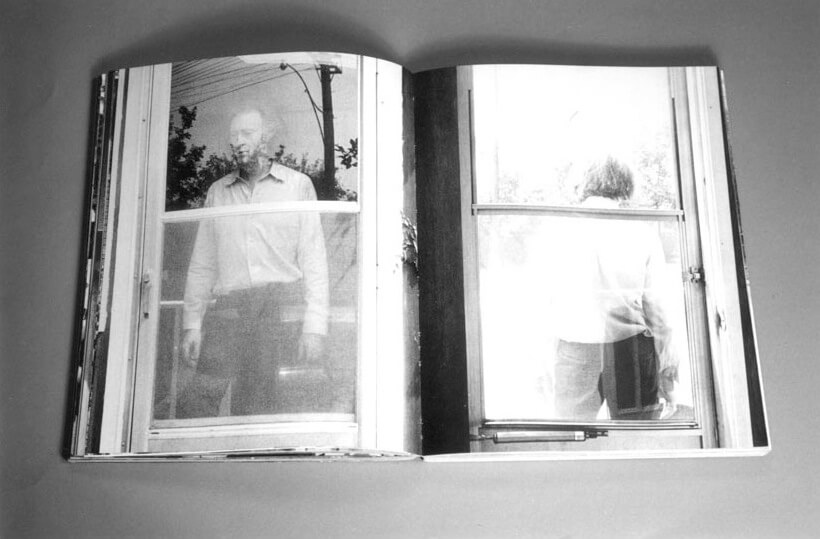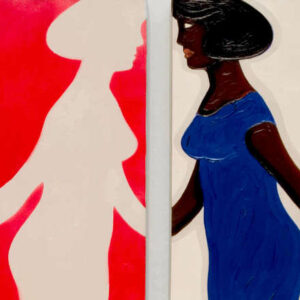Cover to Cover 1975

Michael Snow: Cover to Cover, 1975
Book, 23 x 18 cm
Published by the Press of Nova Scotia College of Art & Design and New York University Press
A work of art by Michael Snow can be difficult to put into words; this is especially true of his recto-verso works, for instance the intriguing two-sided simultaneous projection Two Sides to Every Story, 1974, and a large family of photographic works, including transparencies such as Shade, 1979, and Powers of Two, 2003, and the back-to-back photographic panels of Line Drawing with Synapse, 2003, a design to short-circuit the viewer’s brain. All these works hang in the open space of a gallery, making them sculptures. Here’s the rub: we are accustomed to contemplating sculpture by moving around the object; these works seem somehow to insist that we stand in two places at once. Cover to Cover sets up the same irresistible challenge. As a bookwork it presents as a set of bound signatures, meant to be read cover to cover, meaning front to back, delivering a sequence of images printed full bleed (printed to the edge of the page, without borders). There is no text, so the title printed on the spine must be our guide. One can see at a glance that a single male figure, possibly the artist, is present throughout. From this one might assume that there is narrative structure—a following of this figure from cover to cover, as familiar from memoirs, diaries, or novels. This impression is both right and wrong, for the journey is not smooth.
The book is entirely composed of images made by two photographers aiming their cameras at the object-artist who is caught in a photographic crossfire; sometimes we see the photographers, mostly we do not. Their synchronized exposures result in two parallel sequences. They form a pair that is presented back to back, or recto-verso, on each leaf of the book. In creating this work Snow underlines two characteristics of the photographic image in print: how photographic representation compresses three-dimensional objects, and the thinness of the printed sheet. To do so he had to break the reader’s habits.
Page after page, and spread after spread, Cover to Cover is a mind-twisting arrangement that engages the spectator in an intense game of concentration. To make the connections and move forward, the spectator must remember what is now hidden from view on the previous page. That doesn’t sound so complicated, but it is, because of the kinds of actions executed by the artist. In one passage the figure is recorded moving through a door. On the two-page spread, we see the back of the figure on the left, and the door on the right, though seen from the other side—a suspense-building form of montage. But as the scene “progresses,” an action is not completed within the spread, but loops back in the next one, so that the minimal “progress” extracted from reading left to right is systematically stalled each time a page is turned, and the verso page recapitulates the photographic event printed on the recto side from the opposite angle. This is the disorienting part: to be denied “progress” as one turns the page seems oddly like flashback, which it patently is not; it might be called “extreme simultaneity.” Two versions of the same thing (two sides of the story) are happening at the same time.
And if this seems puzzling, more is on the way: sometime after the midpoint of the book, a rotation occurs within the two-sided system. The images are now upside down. Readers who flip the book over and start paging from the back soon realize that they are looking at images of images produced by the two-sided system, and indeed the very book that they are holding in their hands. This double play of simultaneity underscores Snow’s fascination with the book as object, which he had previously explored in book-shaped sculptures such as Membrane, 1969, and 432101234, 1969. From those early titles, one is alerted to Snow’s awakening interest in the thinness of the sheet and the echoing potential of binding. He began to explore these features, and others, in a catalogue published by the Art Gallery of Ontario, Michael Snow / A Survey (1970), and they are exquisitely displayed in Cover to Cover.

 About the Author
About the Author
 Download PDF
Download PDF
 Credits
Credits